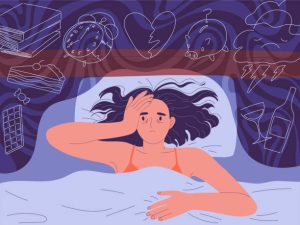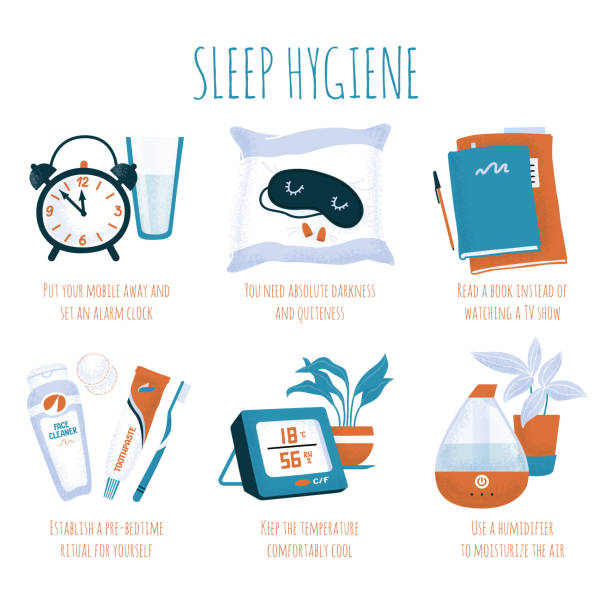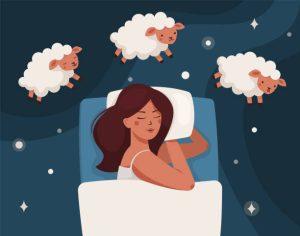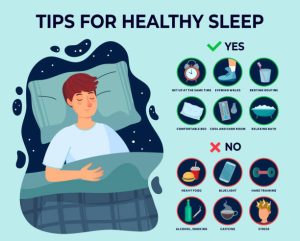Table of Contents
ToggleHave you ever found yourself tossing and turning all night, struggling to get some much-needed shut-eye? Well, it turns out that the temperature of your sleep environment might be the culprit. Yes, you heard that right – temperature plays a crucial role in the quality of your sleep!
As we delve into the science behind this phenomenon, we’ll explore why the right temperature can make all the difference between a restful night’s sleep and a restless one. So, get ready to turn up the heat (or cool it down!) as we uncover the secrets to the perfect sleeping temperature.
Understanding Sleep: Importance, Stages, and Impact on Health

Sleeping is a fundamental human need that enables the body and mind to rest, recover, and rejuvenate. It is a complex process that occurs throughout the night, involving several stages and physiological changes. In essence, sleep reduces consciousness and is accompanied by decreased muscle activity and metabolism.
Sleep Definition
Sleep is a fundamental human need that allows the body and mind to rest, recover, and rejuvenate. It is a complex process that involves several stages and physiological changes that occur throughout the night. In essence, sleep is a state of reduced consciousness that is accompanied by decreased muscle activity and metabolism.
Stages of Sleep
There are two broad types of sleep: non-rapid eye movement (NREM) and rapid eye movement (REM) sleep. NREM sleep is divided into three stages, with each stage characterized by a specific pattern of brain activity.
- First Stage is the lightest stage of sleep, during which the brain produces alpha and theta waves.
- Second Stage is a deeper stage of sleep, during which the brain produces sleep spindles and K-complexes.
- Third Stage is the deepest stage of NREM sleep, also known as slow-wave sleep, during which the brain produces delta waves.
REM sleep, on the other hand, is characterized by rapid eye movements, increased brain activity, and vivid dreams. It usually occurs after a period of NREM sleep and can last anywhere from a few minutes to an hour. During REM sleep, the body becomes paralyzed, which prevents the individual from acting out their dreams.
Importance of Each Stage of Sleep
Each stage of sleep is important for different reasons. During stage 1, the body begins to relax, and the individual may experience hypnagogic hallucinations or brief muscle contractions. Stage 2 is crucial for memory consolidation and is characterized by a reduction in heart rate, body temperature, and breathing rate. Slow-wave sleep, or stage 3, is important for physical restoration, including tissue repair, hormone regulation, and immune system functioning. Finally, REM sleep is essential for cognitive processing, emotional regulation, and creativity.
Impact of Poor Sleep on Health
The impact of poor sleep on health cannot be overstated. Chronic sleep deprivation has been linked to a wide range of health problems, including obesity, diabetes, heart disease, and depression. Sleep apnea, a disorder in which breathing is repeatedly interrupted during sleep, can lead to daytime fatigue, impaired cognitive functioning, and an increased risk of accidents. Insomnia, the inability to fall or stay asleep, can result in irritability, anxiety, and difficulty concentrating.
How Temperature Affects Sleep
Maintaining a comfortable sleep temperature crucially affects the quality and restfulness of sleep. To ensure optimal sleep conditions, one must keep the room temperature within the ideal range, reduce external factors that may impact temperature regulation, and experiment with different temperature settings to determine the most effective option.
Ideal Sleep Temperature Range
The ideal sleep temperature range is between 60 and 67 degrees Fahrenheit (15.5 and 19.4 degrees Celsius). This range promotes optimal conditions for restful sleep by keeping the body’s temperature within the desired range. When the temperature falls outside this range, it can disrupt sleep and affect its quality.
Temperature and Sleep Quality
Temperature affects sleep quality by regulating the body’s internal clock, also known as the circadian rhythm. The body’s temperature naturally drops when it’s time to sleep, signaling the brain to release sleep-inducing hormones like melatonin. If the room temperature is too high, it can make it difficult for the body to cool down, leading to restlessness and difficulty falling asleep. On the other hand, if the room is too cold, it can cause discomfort and wakefulness.
Relationship Between Body Temperature and Sleep
There is a relationship between body temperature and sleep, with the body’s temperature acting as a regulator of the sleep-wake cycle. The body temperature drops by about 1 to 2 degrees Fahrenheit (0.5 to 1 degree Celsius) during the night, helping to promote deep sleep. When the temperature is too high, the body has a hard time cooling down, which can result in increased wakefulness and lighter sleep.
Impact of Room Temperature on Sleep
The impact of room temperature on sleep extends beyond just the body’s internal temperature. The temperature of the room can also affect the quality of sleep by impacting the respiratory system. When the room is too hot, it can cause stuffiness and breathing difficulties, leading to snoring and sleep apnea. When the room is too cold, it can cause dryness and irritation of the nasal passages, leading to congestion and discomfort.
Factors That Affect Temperature Regulation

Temperature regulation is a crucial aspect of maintaining homeostasis in the body. Several factors can affect the ability of an individual’s body to regulate its temperature. These factors include age, gender, health conditions, hormones, and environment.
Age
As we age, our ability to regulate our body temperature decreases. This is because our thermoregulatory mechanisms become less efficient. Infants and elderly individuals are more susceptible to temperature fluctuations due to their less efficient thermoregulatory mechanisms. Infants have a higher surface area-to-body mass ratio, which means they lose heat more quickly than adults. Older individuals have a decreased ability to sweat and shiver, which are mechanisms the body uses to regulate its temperature.
Gender
Gender also affects temperature regulation. Women generally have a higher core body temperature than men, which can result in a higher thermal load during exercise. Menstrual cycles also impact temperature regulation in women. During the luteal phase, progesterone levels increase, which can lead to a slightly elevated core temperature.
Health Conditions
Several health conditions can affect an individual’s ability to regulate their body temperature. Individuals with diabetes, thyroid disorders, and cardiovascular disease may have impaired thermoregulatory responses. Heat exhaustion and heat stroke can occur when the body is unable to cool itself adequately during exercise or exposure to hot environments. On the other hand, individuals with anorexia nervosa, bulimia nervosa, or other eating disorders may have lower body temperatures due to their decreased body fat and muscle mass.
Hormones
Hormones play a crucial role in temperature regulation. Thyroid hormones influence metabolism, which affects heat production. Estrogen and progesterone levels can impact temperature regulation in women. During menopause, women may experience hot flashes due to hormonal changes.
Environment
The environment can have a significant impact on temperature regulation. Exposure to extreme temperatures, either hot or cold, can result in heat exhaustion, heat stroke, hypothermia, or frostbite. Humidity can also affect temperature regulation, as high humidity can impede sweat evaporation, making it more difficult for the body to cool itself.
Tips for Achieving Optimal Sleep Temperature

To get a good night’s sleep, it’s essential to achieve optimal sleep temperature. Our body temperature naturally drops when we sleep, and we can support this process by creating a comfortable sleep environment. So, here are some tips to help you achieve the perfect temperature for optimal sleep.
Adjusting Room Temperature
To achieve the perfect temperature for optimal sleep, adjusting the room temperature is crucial. Ideally, the temperature in your bedroom should be between 60 and 67 degrees Fahrenheit. Keeping the room too hot can make it difficult to sleep, as it can cause discomfort and sweating. On the other hand, sleeping in a room that’s too cold can cause shivering and discomfort. So, it’s essential to find the right temperature that works best for you.
Choosing the Right Bedding
Choosing the right bedding is another important factor in achieving optimal sleep temperature. Lightweight, breathable fabrics like cotton or linen can help to regulate your body temperature while sleeping.
These materials help to wick away moisture and promote airflow, preventing you from feeling too hot or too cold during the night. Using a weighted blanket can also be beneficial for some individuals, as it can help to regulate body temperature and promote a sense of comfort.
Fan or Air Conditioning
Using a fan or air conditioning can help to regulate the temperature in your bedroom. Fans can help to circulate cool air throughout the room, while air conditioning can help to keep the temperature consistent. It’s important to keep in mind that using these devices can also increase your energy consumption, so it’s important to find a balance that works for you.
Taking a Warm Bath or Shower Before Bed
Taking a warm bath or shower before bed can help to regulate your body temperature and promote relaxation. As your body temperature rises during the bath or shower, it naturally cools down afterward, which can promote feelings of drowsiness and help to prepare your body for sleep.
Using a Heating Pad or Hot Water Bottle
Using a heating pad or hot water bottle can also be useful for regulating your body temperature. Placing the heating pad or hot water bottle on your feet or legs can help to warm up your body, which can promote feelings of comfort and relaxation.
Technology and Sleep Temperature: The Impact of Smart Thermostats

Smart thermostats, such as the Nest and Ecobee, have revolutionized the way we regulate the temperature of our homes. These devices allow users to control the temperature of their home from their phone or computer, making it easy to find the perfect temperature for a good night’s rest.
By setting the temperature to their preferred level before getting into bed, users can optimize their sleep environment and improve their overall sleep quality.
Sleep Tracking Devices and Temperature: How Wearables Can Help
Sleep tracking devices, such as Fitbit and the Oura ring, are wearable devices that monitor a person’s sleep patterns. Some of these devices also track the temperature of the room throughout the night, allowing users to determine if temperature changes are affecting their sleep quality.
By analyzing this data, users can make adjustments to their sleep environment to ensure they are getting the best possible rest.
Cooling and Heating Mattress Pads: The Benefits of Temperature Control
Cooling and heating mattress pads use technology to either cool or warm the surface of the bed, making it easier for people to stay comfortable throughout the night. These pads can be especially helpful for those who experience hot flashes or night sweats during menopause, as well as those who sleep next to a partner with different temperature preferences.
By adjusting the temperature of the bed, these pads can improve sleep quality and help users wake up feeling refreshed.
The Future of Sleep Technology: Advancements in Temperature Regulation
As technology advances, we can expect to see even more innovations in the field of sleep temperature regulation. One promising development is the use of AI-powered systems that can automatically adjust the room’s temperature based on a person’s sleep patterns. By analyzing data from sleep tracking devices, these systems can create a personalized sleep environment that optimizes temperature for each individual.
As these technologies become more widespread, we can look forward to a future where getting a good night’s sleep is easier and more accessible than ever before.
The Connection Between Temperature and Sleep Disorders

The connection between temperature and sleep disorders is evident. Temperature extremes can make it difficult for individuals to fall asleep, stay asleep, and feel well-rested upon waking up. Temperature can impact sleep disorders such as insomnia, sleep apnea, restless leg syndrome, and narcolepsy.
Insomnia
Insomnia is a sleep disorder characterized by difficulty falling or staying asleep. Temperature plays a crucial role in the quality and duration of sleep for individuals with insomnia. High temperatures can cause discomfort and sweating, making it difficult to fall asleep, while low temperatures can cause shivering and discomfort, leading to difficulty staying asleep. Creating a comfortable sleeping environment with a consistent temperature is essential to combat insomnia.
Sleep Apnea
Sleep apnea is a disorder in which a person’s breathing is repeatedly interrupted during sleep. Temperature can impact the airways and exacerbate sleep apnea symptoms. High temperatures can cause airways to narrow and make breathing more difficult, while lower temperatures can cause airways to constrict, making it more challenging to breathe. Maintaining a consistent temperature can help alleviate symptoms of sleep apnea.
Restless Leg Syndrome
Restless leg syndrome (RLS) is a disorder characterized by an irresistible urge to move the legs, often causing discomfort and difficulty sleeping. Temperature can worsen RLS symptoms and disrupt sleep quality. High temperatures can lead to more frequent leg movements and disruptions in sleep. Keeping the room cool can help alleviate symptoms of RLS and improve sleep quality.
Narcolepsy
Narcolepsy is a disorder in which a person experiences excessive daytime sleepiness and can fall asleep suddenly and without warning. Temperature can impact the body’s circadian rhythms, which can disrupt sleep-wake cycles and exacerbate symptoms of narcolepsy. Maintaining a consistent and cool temperature can help regulate the body’s natural sleep-wake cycles and alleviate symptoms of narcolepsy.
The Impact of Temperature on Different Sleepers

Different groups of people experience varying impacts of temperature on their sleep. Temperature changes can cause sleep disturbances in infants and young children, who are particularly sensitive to such changes. Inappropriate room temperature can exacerbate the problem, causing discomfort and restlessness in young children.
Infants and Young Children
Infants and young children are particularly sensitive to temperature changes and require a specific room temperature to ensure a comfortable sleeping environment. The ideal temperature for babies to sleep is around 68-72°F (20-22°C), which helps them feel comfortable and ensures they don’t get too cold or too hot. Parents should take extra precautions to keep the baby’s sleeping environment safe, including using a properly fitting sleep sack instead of blankets or other loose bedding.
Older Adults
As we age, our bodies become less efficient at regulating temperature, making it harder for us to stay warm in cold environments and cool in warm environments. Older adults may have health conditions or take medications that affect their body temperature.
A room temperature between 65-70°F (18-21°C) is generally recommended for older adults to ensure they can maintain a comfortable body temperature and get a good night’s sleep.
Pregnant Women
Pregnant women may have different temperature needs due to hormonal changes and increased blood volume. Many women experience hot flashes or night sweats during pregnancy, which can make it difficult to sleep. Overheating can be dangerous for pregnant women and their developing babies.
The recommended room temperature for pregnant women is around 65-70°F (18-21°C) to ensure they don’t overheat and can stay comfortable throughout the night.
People with Chronic Pain
People with chronic pain may also be sensitive to temperature changes. Cold temperatures can make joints and muscles feel stiff and achy, while hot temperatures can make inflammation worse. The ideal temperature for people with chronic pain may vary depending on their individual needs, but a room temperature between 65-72°F (18-22°C) is generally recommended.
Maintaining a comfortable sleeping environment can help alleviate pain and improve the quality of sleep.
The Relationship Between Temperature and Sleep Hygiene

Regulating the temperature to achieve a comfortable sleeping environment is crucial for achieving quality sleep and creating a sleep-conducive environment. A consistent sleep schedule also plays a significant role in regulating the body’s natural sleep-wake cycle, promoting better sleep.
Avoiding bright lights before bed and using warm and dim lighting can promote relaxation, prepare the body for sleep, and regulate temperature. Implementing these practices can help individuals improve their sleep hygiene and achieve a better night’s rest.
Creating a Sleep-Conducive Environment
To achieve quality sleep, it is crucial to create a sleep-conducive environment. One key factor in this is regulating the temperature of the bedroom. The ideal temperature range for a good night’s rest is between 60 and 67 degrees Fahrenheit. Any temperature outside this range can disrupt sleep patterns and lead to discomfort. By regulating the temperature in the bedroom, individuals can create a comfortable sleeping environment that promotes better sleep.
The Importance of a Consistent Sleep Schedule
Maintaining a consistent sleep schedule is essential for good sleep hygiene. The body’s natural sleep-wake cycle, also known as the circadian rhythm, can be disrupted by inconsistent sleep patterns. Going to bed and waking up at the same time each day can help to regulate the circadian rhythm and promote better sleep. By maintaining a consistent sleep schedule, individuals can improve their sleep quality and overall well-being.
The Role of Light in Temperature Regulation
Light plays a crucial role in temperature regulation and can affect the quality of sleep. The body’s temperature naturally drops as bedtime approaches, but exposure to bright light in the evening can delay this process and disrupt sleep. It is recommended to avoid electronics or bright lights before bed, as they can interfere with the body’s natural temperature regulation. Warm and dim lighting in the evening can promote relaxation and prepare the body for sleep. On the other hand, bright and cool lighting can have the opposite effect and stimulate the body, making it harder to fall asleep. By understanding the role of light in temperature regulation, individuals can create an environment that promotes quality sleep.
The Effects of Temperature on Dreams

Our dream experiences are significantly impacted by temperature, as it affects the various stages of sleep, and the emotional content of our dreams, and can even induce lucid dreaming. By understanding this impact, we can optimize our sleep environment and potentially improve the quality and frequency of our dreams.
The relationship between REM sleep and temperature
Research has shown that temperature plays a significant role in the different stages of sleep, particularly during the Rapid Eye Movement (REM) stage. During REM sleep, our body temperature naturally drops, which may help to stimulate vivid and memorable dreams.
The impact of temperature on dream content
Temperature can also affect the content of our dreams. If we are too warm or too cold while we sleep, we may experience more negative dreams, such as nightmares or anxiety-provoking dreams. Conversely, if we are comfortable and cozy, we may have more positive, happy dreams. This is because the temperature can affect our emotional state, which is then reflected in our dream content.
The Role of Temperature in lucid dreaming
Temperature can also play a role in inducing lucid dreams. When our body temperature is slightly elevated, such as when we have a fever, we may be more likely to experience lucid dreams. Similarly, using devices like sleep masks that gently warm the face can increase the likelihood of lucid dreaming.
Practical implications
There are several practical implications of these findings. By understanding the impact of temperature on our dreams, we can optimize our sleep environment to improve the quality and frequency of our dreams.
Maintaining a comfortable room temperature, between 60-67°F, can help to promote restful sleep and positive dreams. Using cooling or warming devices, such as a fan or heating pad, can help regulate our body temperature and potentially enhance our dream experience.

FAQ
| Question | Answer |
|---|---|
| How can I determine my optimal sleep temperature? | The optimal sleep temperature varies from person to person, but it generally falls between 60-67°F (15-19°C). Experiment with different temperatures and observe how you feel in the morning. |
| Is it better to be too hot or too cold when sleeping? | It is better to be a bit cool rather than too hot when sleeping. When you are too hot, you are likely to experience discomfort and have trouble sleeping. On the other hand, being a bit cool can help you fall asleep faster and improve your overall sleep quality. |
| Can sleeping in a colder room help with weight loss? | There is some evidence that sleeping in a colder room can boost your metabolism, which may lead to weight loss. However, this effect is likely to be modest and is not a substitute for a healthy diet and regular exercise. |
| Can sleeping in a warmer room improve my immune system? | While there is no direct evidence that sleeping in a warmer room can boost your immune system, it is known that a good night’s sleep is essential for a healthy immune system. If you are comfortable in a warmer room and can sleep soundly, it may indirectly benefit your immune system. |
| What is the ideal room temperature for a good night’s sleep? | The ideal room temperature for a good night’s sleep is generally between 60-67°F (15-19°C), although this can vary slightly depending on your personal preferences. Keep your room cool, dark, and quiet to create the most optimal sleep environment. |









